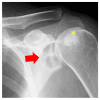Intraosseous Pneumatocysts of the Scapula Mimicking Bone Tumors: A Report of Two Rare Cases Along with Elucidation of Their Etiology
- PMID: 40558581
- PMCID: PMC12191598
- DOI: 10.3390/diseases13060170
Intraosseous Pneumatocysts of the Scapula Mimicking Bone Tumors: A Report of Two Rare Cases Along with Elucidation of Their Etiology
Abstract
Background/objectives: Pneumatocysts, characterized by gas-filled cavities, are commonly found in the spine and pelvis but are rarely observed in the scapula. In this report, we describe two rare cases of scapular pneumatocysts mimicking bone tumors and exhibiting different image findings.
Case report: Case 1. A 47-year-old man who presented with neck pain underwent radiography, followed by magnetic resonance imaging (MRI). MRI showed heterogeneity with low and high signals on fat-suppressed T2-weighted images, suggestive of enchondroma or fibrous dysplasia (FD). However, preoperative computed tomography (CT) revealed gas-filled cavities within the tumor, in continuity with the shoulder joint, confirming the diagnosis of a pneumatocyst.
Case 2: A 58-year-old woman who presented with neck pain underwent similar examinations to Case 1. MRI showed homogeneity with high signals on fat-suppressed T2-weighted images, leading to a suspicion of solitary bone cysts and FD. Preoperative CT revealed gas-filled cavities within the tumor, but no continuity with the joint, leading to the diagnosis of a pneumatocyst. While the exact etiology of pneumatocysts remains unclear, two potential causes are as follows: (i) gas migration from the joint to the bone, and (ii) gas replacement in cystic tumors. Thus, CT is particularly valuable in confirming the presence of gas-filled cavities and aiding in diagnosis.
Conclusions: This report highlights two extremely rare cases of scapular pneumatocysts, reflecting two potential etiologies. The utility of CT in the diagnosis of pneumatocyst has been clarified.
Keywords: computed tomography; differential diagnosis; magnetic resonance imaging; pneumatocyst.
Conflict of interest statement
The authors declare no conflicts of interest.
Figures






Similar articles
-
Drugs for preventing postoperative nausea and vomiting in adults after general anaesthesia: a network meta-analysis.Cochrane Database Syst Rev. 2020 Oct 19;10(10):CD012859. doi: 10.1002/14651858.CD012859.pub2. Cochrane Database Syst Rev. 2020. PMID: 33075160 Free PMC article.
-
Physical exercise training interventions for children and young adults during and after treatment for childhood cancer.Cochrane Database Syst Rev. 2016 Mar 31;3(3):CD008796. doi: 10.1002/14651858.CD008796.pub3. Cochrane Database Syst Rev. 2016. PMID: 27030386 Free PMC article.
-
Treatment for osteoporosis in people with beta-thalassaemia.Cochrane Database Syst Rev. 2023 May 9;5(5):CD010429. doi: 10.1002/14651858.CD010429.pub3. Cochrane Database Syst Rev. 2023. PMID: 37159055 Free PMC article.
-
Impact of residual disease as a prognostic factor for survival in women with advanced epithelial ovarian cancer after primary surgery.Cochrane Database Syst Rev. 2022 Sep 26;9(9):CD015048. doi: 10.1002/14651858.CD015048.pub2. Cochrane Database Syst Rev. 2022. PMID: 36161421 Free PMC article.
-
Imaging modalities for the non-invasive diagnosis of endometriosis.Cochrane Database Syst Rev. 2016 Feb 26;2(2):CD009591. doi: 10.1002/14651858.CD009591.pub2. Cochrane Database Syst Rev. 2016. PMID: 26919512 Free PMC article.
References
Publication types
LinkOut - more resources
Full Text Sources

